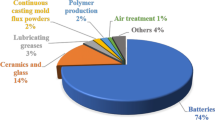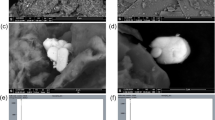Abstract
The effect of bis-(2-ethylhexyl)phosphoric acid (DEHPA) on the region of existence, conductivity and structure of sodium bis-(2-ethylhexyl)phosphate (NaDEHP) microemulsion has a dual nature and depends on DEHPA concentration. In the system NaDEHP–DEHPA–kerosene–water, the narrowing of the microemulsion region is observed with DEHPA concentration in the organic phase growth from 0.1 to 0.5 mol/L. The increase of DEHPA concentration in the organic phase from 0.1 to 0.4 mol/L leads to the reduction of electrical conductivity of the microemulsions. Based on the conductivity and viscosity measurements, we suppose the transition from reverse microemulsion with isolated droplets to percolate microemulsion at volume fraction of water 0.18 ( \(W = C_{{H_{2} O}} /C_{\text{NaDEHP}}\) = 8). Droplet size of the microemulsions increases linearly with W growth. The rise of DEHPA concentration in the organic phase from 0.1 to 0.3 mol/L causes the growth of the coefficient at W in the equation d = kW + b from 0.038 to 0.249, i.e., it increases the slope of the lines. In contrast, DEHPA introduction at the concentration 0.1 mol/L (in the organic phase) leads to the expansion of the microemulsion region, does not affect the conductivity and decreases the coefficient at W. The rate of copper recovery into the microemulsion increases considerably with the rise of DEHPA concentration from 0.0 to 0.3 mol/L; no dual effect is observed. The following composition of the microemulsion for non-ferrous metals leaching is recommended: C NaDEHP = 1.6 mol/L, C DEHPA = 0.3 mol/L (in the organic phase); W = 8–32.






Similar content being viewed by others
References
Kumar P, Mittal KL (eds) (1999) Handbook of microemulsion science and technology. Marcel Dekker, New York
McEvoy E, Donegan S, Power J et al (2007) Recent advances in the development and application of microemulsion EKC. Electrophoresis 28:193–207
López-Quintela MA, Tojo C, Blanco MC et al (2004) Microemulsion dynamics and reactions in microemulsions. Curr Opin Colloid Interface Sci 9:264–278
Xu X-J, Gan LM (2005) Recent advances in the synthesis of nanoparticles of polymer latexes with high polymer-to-surfactant ratios by microemulsion polymerization. Curr Opin Colloid Interface Sci 10:239–244
Pileni MP (1997) Nanosized particles made in colloidal assemblies. Langmuir 13:3266–3276
Capek I (2004) Preparation of metal nanoparticles in water-in-oil (w/o) microemulsions. Adv Colloid Interface Sci 110:49–74
Salager JL, Forgiarini AM, Bullon J (2013) How to attain an ultralow interfacial tension and three-phase behavior with a surfactant formulation for enhanced oil recovery: a review. Part 1. optimum formulation for simple surfactant-oil-water ternary systems. J Surfact Deterg 16:449–472
Watarai H (1997) Microemulsions in separation sciences. J Chromatogr A 780:93–102
Tondre C (1999) Surfactant-based colloidal particles as the extracting phase for the removal of metal ions from aqueous environments: kinetic and applied aspects. ACS Symp Ser 740:139–157
Osseo-Asare K (1988) Enhanced solvent extraction with water-in-oil microemulsions. Sep Sci Technol 23:1269–1284
Brejza EV, Perez de Ortiz SE (2000) Phenomena affecting the equilibrium of Al(III) and Zn(II) extraction with Winsor II microemulsions. J Colloid Interface Sci 227:244–246
Zhao YY, Tao Z, Chuan-Bo X, Xue-Mei X, Ling L, Zhan-Yu L (2008) Study on the extraction of cobalt and nickel from NH4SCN solution by Winsor II microemulsion system. Sep Purif Technol 60:174–179
He D, Yang C, Ma M, Zhuang L, Chen X, Chen S (2004) Studies of the chemical properties of tri-n-octylamine–secondary octanol–kerosene–HCl–H2O microemulsions and its extraction characteristics for cadmium (II). Colloids Surf A 232:39–47
Yurtov EV, Murashova NM (2011) Leaching the metals with extractant containing microemulsions. Theor Found Chem Eng 45:726–730
Faure A, Tistchenko AM, Zemb T, Chachaty C (1985) Aggregation and dynamical behavior in sodium diethyl phosphate/ware/benzene inverted micelles. J Phys Chem 89:3373–3378
Yu Z-J, Neuman RD (1995) Reversed micellar solution-to-bicontinuous microemulsion transition in sodium bis(2-ethylhexyl)phosphate/n-heptane/water system. Langmuir 11:1081–1086
Kurumada K, Nagamine Sh, Tanigaki M (1999) Structure and properties of bis(2-ethylhexyl)phosphoric acid microemulsions with a network structure. Effect of counter ions. Colloids Surf A 148:305–311
Yurtov EV, Murashova NM (2004) Phase equilibria and nonequilibrium structures in the sodium di-2-ethylhexyl phosphate-decane-water system. Colloid J 66:629–634
Gaonkar AG, Neuman RD (1987) Interfacial activity, extractant selectivity and reversed micellization in hydrometallurgical liquid/liquid extraction systems. J Colloid Interface Sci 119:251–261
Li Q, Li T, Wu J (2002) Water solubilization capacity and conductance behaviors of AOT and NaDEHP systems in the presence of additives. Colloids Surf A 197:101–109
Chakraborty I, Moulik SP (2005) Physicochemical studies on microemulsions 9. Conductance percolation of AOT-derived W/O microemulsion with aliphatic and aromatic hydrocarbon oils. J Colloid Interface Sci 289:530–541
Cid-Samamed A, Garcia-Rio L, Fernandez-Gandara D, Mejuto JC, Morales J, Pérez-Lorenzo M (2008) Influence of n-alkyl acids on the percolative phenomena in AOT-based microemulsions. J Colloid Interface Sci 318:525–529
Gradzielski M, Hoffmann H (1999) Rheological Properties of Microernulsions. In: Kumar P, Mittal KL (eds) Handbook of microemulsion science and technology. Marcel Dekker, New York, pp 357–386
Kljajic A, Bester-Rogac M, Trost S, Zupet R, Pejovnik S (2011) Characterization of water/sodium bis(2-ethylhexyl) sulfosuccinate/sodium bis(amyl) sulfosuccinate/n-heptane mixed reverse micelles and w/o microemulsion systems: the influence of water and sodium bis(amyl) sulfosuccinate content. Colloids Surf A 385:249–255
Borkovec M, Eicke H-F, Hammerich H, Das Gupta B (1988) Two percolation processes in microemulsions. J Phys Chem 92:206–211
Mehta SK, Kaur K, Kaur G, Bhasin KK (2009) Percolating phenomenon in microemulsions: effect of external entity. In: Fanun M (ed) Microemulsions: properties and applications. CRC Press, USA, pp 59–76
Burauer S, Belkoura L, Stubenrauch C, Strey R (2003) Bicontinuous microemulsions revisited: a new approach to freze fracture electron microscopy (FFEM). Colloids Surf A 228:159–170
Eicke H-F (1986) Aqueous nanophases in liquid hydrocarbons stabilized by ionic surfactants. In: Parfitt D, Eicke H-F (eds) Interfacial phenomena in apolar media. Marcel Dekker Inc, Basel, pp 41–89
Takashina S, Yoshida M, Gotoh K, Oshitani J (2008) Phase behavior and size variation of AOT-based W/O microemulsions by substituting H+ for Na+ as the counterion. Colloids Surf A 325:52–56
Hanson C (ed) (1971) Recent advances in liquid–liquid extraction. Pergamon Press, New York
Rydberg J, Cox M, Musikas C, Choppin GR (eds) (2004) Solvent extraction principles and practice. Marcel Dekker, New York
Yurtov EV, Murashova NM. (2008) Microemulsion leaching of metals. In: Moyer, B.A. (ed.) Solvent extraction: fundamentals to industrial applications, proceedings of ISEC 2008 international solvent extraction conference, the Canadian Institute of Mining, Metallurgy and Petroleum, Montreal, pp.1597–1602
Author information
Authors and Affiliations
Corresponding author
About this article
Cite this article
Murashova, N.M., Levchishin, S.Y. & Yurtov, E.V. Effect of Bis-(2-ethylhexyl)Phosphoric Acid on Sodium Bis-(2-ethylhexyl)Phosphate Microemulsion for Selective Extraction of Non-Ferrous Metals. J Surfact Deterg 17, 1249–1258 (2014). https://doi.org/10.1007/s11743-014-1598-x
Received:
Accepted:
Published:
Issue Date:
DOI: https://doi.org/10.1007/s11743-014-1598-x




